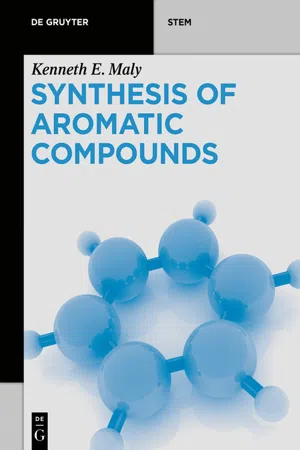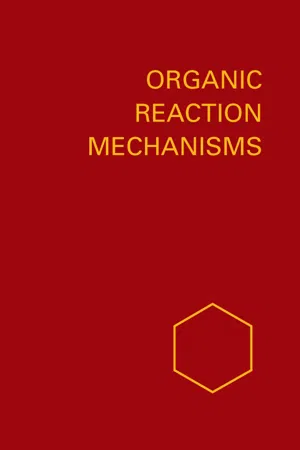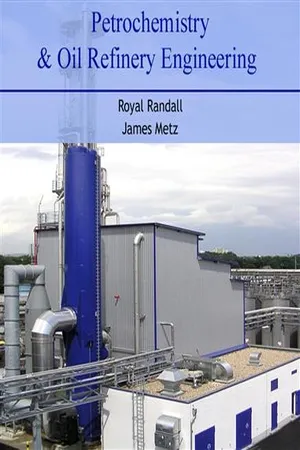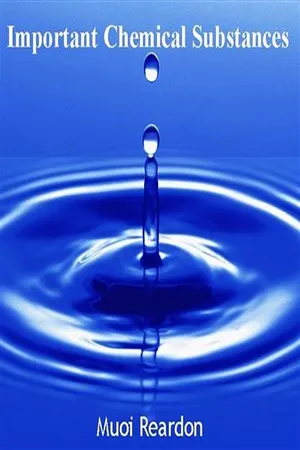Chemistry
Benzyne
Benzyne is a highly reactive and unstable intermediate in organic chemistry, consisting of a six-membered ring with two adjacent carbon atoms replaced by a triple bond. It is often generated in situ and is known for its ability to undergo various types of reactions, making it a valuable synthetic intermediate in organic chemistry.
Written by Perlego with AI-assistance
Related key terms
1 of 5
4 Key excerpts on "Benzyne"
- eBook - ePub
- Kenneth E. Maly, Kenneth Maly(Authors)
- 2022(Publication Date)
- De Gruyter(Publisher)
5 Benzynes5.1 Introduction to Benzynes
1,2-Didehydrobenzene (Benzyne) was first proposed as a reactive intermediate by Wittig in 1942 [1 ]. Subsequently, the existence of Benzyne was established by Roberts in 1953 by the reaction of 14 C-labeled chlorobenzene with sodium amide (Figure 5.1 ) [2 ].Figure 5.1: Preparation of Benzyne by Roberts [2 ].Arynes (the generalized term for didehydroaromatic compounds) are highly reactive intermediates and are therefore generated in situ. Arynes are typically represented as a strained alkyne with the second π-bond being orthogonal to the aromatic system. They can also be viewed as a singlet diradical species, although computational and experimental studies suggest that there is more bonding character than radical character [3 ]. Because the π-bond is perpendicular to the aromatic π-system, the reactivity of the aryne is not affected much by resonance – rather inductive effects of substituents dominate.Arynes undergo a variety of reactions, including cycloadditions, reactions with nucleophiles, and transition metal-mediated reactions [4 , 5 ]. Indeed, aryne chemistry has developed to such an extent that arynes are often used in the total synthesis of natural products [6 , 7 ], as well as the preparation of other complex aromatic architectures such as polycyclic aromatic hydrocarbons [8 ]. In this chapter, we will explore the methods for generating arynes, describe their reactivity, and highlight their utility in the organic synthesis.5.2 Formation of Benzynes
The early methods for forming arynes involved either strong bases or high temperatures. For example, Benzyne can be generated by reaction of a halobenzene with a strong base such as sodium amide in a beta elimination reaction, elimination of fluoride from an ortho-fluoro Grignard or aryllithium species, or by expulsion of CO2 and N2 from an ortho-aryl diazonium carboxylate. More recently, methods for formation of arynes using milder conditions, such as the fluoride induced elimination of trimethylsilyl aryl triflates have been developed. The most common methods for forming arynes are summarized in Figure 5.2 - eBook - PDF
Organic Reaction Mechanisms 1975
An annual survey covering the literature dated December 1974 through November 1975
- A. R. Butler, M. J. Perkins, A. R. Butler, M. J. Perkins(Authors)
- 2008(Publication Date)
- Wiley-Interscience(Publisher)
268 Organic Reactim Mechlzisms 1975 0 (45) group of N-benzylideneanilinel78have been reported. Benzyne reacts with carbon di- sulphidel79 to give the carbene (46) which can be trapped by protic substances to give the 1,3-benzodithiolylium ion, and this then undergoes further reaction with nucleo- philes; in the absence of protic substances, dimerization of the carbene occurs. 2,3- Diphenyl-l,4-benzodithiin (47) has been isolated from the reaction of phenyl-lithium and bromobenzene with carbon disulphide.180 The reaction of Benzyne with (dimethyl- aminomethyl)trimethylsilanel'31 gives predominantly [l-(methylpheny~amino)ethy~]- trimethylsilane (48) although with (dimethylaminomethy1)triphenylsilane the new rearrangement product (49) is also formed.182 A direct method for the preparation of substituted naphthalenes and naphthols by reaction of Benzyne with dienolate anions has been described.183 Reaction with Benzyne followed by sulphoxide pyrolysis has proved useful in the conversion of dithia- [3.3]cyclophanes into cyclophanedienes.184 TetrachloroBenzyne has found use in an attempted synthesis of acetylene diethers,Js and there has been further study of the reactions of tetrafluoroBenzyne with carboxylic acids in cyclic ethers.186 There hss also been further study of the previously reported pyrolysis of sodium pentafluorobenzoate to give octafluoroxanthone via tetrafluoroBenzyne.187 Other Reactions The rates of replacement of the 2-substituent in 2-X-tropones (X = F, C1, Br, I or N(CH2CHz)&HI-) by sodium toluene-p-thiolate in dimethyl sulphoxide have been measured188 and have been compared with rates for reaction with primary and secondary amines. The amidination of tropones to give l,3-diaza-azulenes (SO) has also been re- ported189 and probably involves hydride replacement by the amidine followed by car- bony1 condensation. - No longer available |Learn more
- (Author)
- 2014(Publication Date)
- Academic Studio(Publisher)
________________________ WORLD TECHNOLOGIES ________________________ Chapter 5 Benzene Benzene IUPAC name Benzene Other names Benzol cyclohexa-1,3,5-triene Identifiers CAS number 71-43-2 PubChem 241 ChemSpider 236 UNII J64922108F KEGG C01407 ChEBI CHEBI:16716 ChEMBL CHEMBL277500 RTECS number CY1400000 Properties Molecular formula C 6 H 6 Molar mass 78.11 g mol −1 Appearance Colorless liquid Density 0.8765(20) g/cm 3 Melting point 5.5 °C, 279 K, 42 °F Boiling point 80.1 °C, 353 K, 176 °F Solubility in water 1.8 g/L (15 °C) ________________________ WORLD TECHNOLOGIES ________________________ Viscosity 0.652 cP at 20 °C Dipole moment 0 D Hazards MSDS External MSDS EU classification Flammable ( F ) Carc. Cat. 1 Muta. Cat. 2 Toxic ( T ) R-phrases R45, R46, R11, R36/38,R48/23/24/25, R65 S-phrases S53, S45 Flash point −11 °C Related compounds Related compounds toluene borazine Supplementary data page Structure and properties n , ε r , etc. Thermodynamic data Phase behaviour Solid, liquid, gas Spectral data UV, IR, NMR, MS Benzene is an organic chemical compound with the molecular formula C 6 H 6 . It is sometimes abbreviated Ph–H. Benzene is a colorless and highly flammable liquid with a sweet smell. Because it is a known carcinogen, its use as an additive in gasoline is now limited, but it is an important industrial solvent and precursor in the production of drugs, plastics, synthetic rubber, and dyes. Benzene is a natural constituent of crude oil, and may be synthesized from other compounds present in petroleum. Benzene is an aromatic hydrocarbon and the second [ n ]-annulene (-annulene), a cyclic hydrocarbon with a continuous pi bond. It is also related to the functional group arene which is a generalized structure of benzene. History Discovery The word benzene derives historically from gum benzoin, sometimes called ben-jamin (i.e., benzoin resin), an aromatic resin known to European pharmacists and perfumers since the 15th century as a product of southeast Asia. - No longer available |Learn more
- (Author)
- 2014(Publication Date)
- Research World(Publisher)
________________________ WORLD TECHNOLOGIES ________________________ Chapter- 5 Benzene Benzene IUPAC name Benzene Other names Benzol cyclohexa-1,3,5-triene Identifiers CAS number 71-43-2 PubChem 241 ChemSpider 236 UNII J64922108F KEGG C01407 ChEBI CHEBI:16716 ChEMBL CHEMBL277500 RTECS number CY1400000 Properties Molecular formula C 6 H 6 Molar mass 78.11 g mol −1 Appearance Colorless liquid Density 0.8765(20) g/cm 3 Melting point 5.5 °C, 279 K, 42 °F ________________________ WORLD TECHNOLOGIES ________________________ Boiling point 80.1 °C, 353 K, 176 °F Solubility in water 1.8 g/L (15 °C) Viscosity 0.652 cP at 20 °C Dipole moment 0 D Hazards MSDS External MSDS EU classification Flammable ( F ) Carc. Cat. 1 Muta. Cat. 2 Toxic ( T ) R-phrases R45, R46, R11, R36/38,R48/23/24/25, R65 S-phrases S53, S45 Flash point −11 °C Related compounds Related compounds toluene borazine Supplementary data page Structure and properties n , ε r , etc. Thermodynamic data Phase behaviour Solid, liquid, gas Spectral data UV, IR, NMR, MS Benzene is an organic chemical compound with the molecular formula C 6 H 6 . It is sometimes abbreviated Ph–H. Benzene is a colorless and highly flammable liquid with a sweet smell. Because it is a known carcinogen, its use as an additive in gasoline is now limited, but it is an important industrial solvent and precursor in the production of drugs, plastics, synthetic rubber, and dyes. Benzene is a natural constituent of crude oil, and may be synthesized from other compounds present in petroleum. Benzene is an aromatic hydrocarbon and the second [ n ]-annulene (-annulene), a cyclic hydrocarbon with a continuous pi bond. It is also related to the functional group arene which is a generalized structure of benzene. History Discovery The word benzene derives historically from gum benzoin, sometimes called benjamin (i.e., benzoin resin), an aromatic resin known to European pharmacists and perfumers since the 15th century as a product of southeast Asia.
Index pages curate the most relevant extracts from our library of academic textbooks. They’ve been created using an in-house natural language model (NLM), each adding context and meaning to key research topics.



